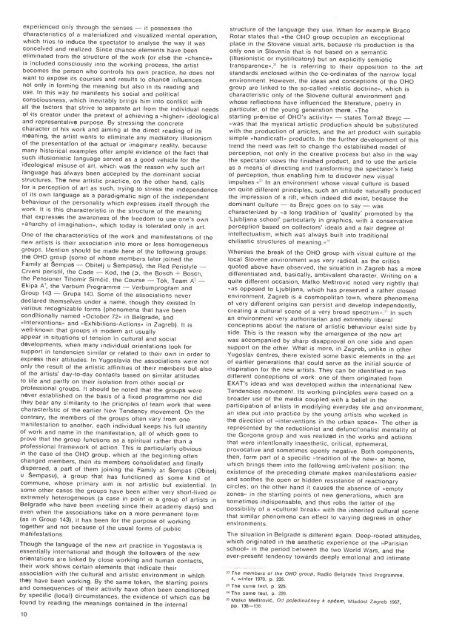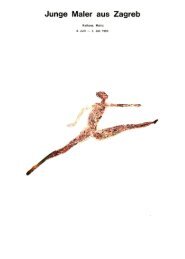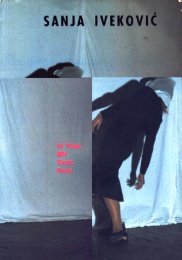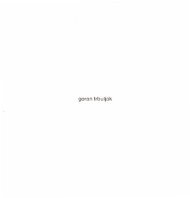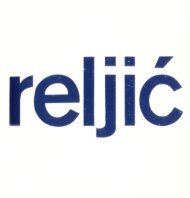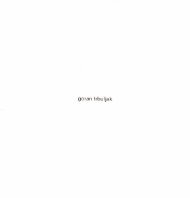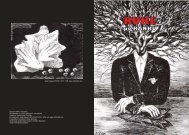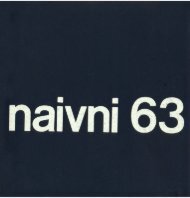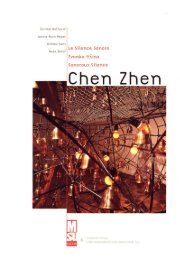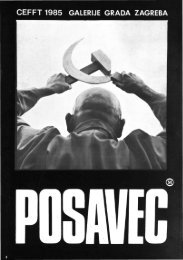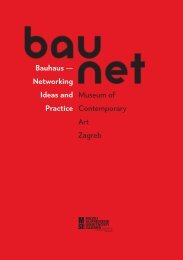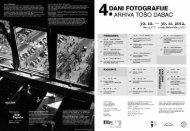The New Art Practice in Yugoslavia, 1966-1978
The New Art Practice in Yugoslavia, 1966-1978
The New Art Practice in Yugoslavia, 1966-1978
- TAGS
- practice
- yugoslavia
- www.msu.hr
Create successful ePaper yourself
Turn your PDF publications into a flip-book with our unique Google optimized e-Paper software.
experienced only through the senses it possesses the<br />
characteristics of a materialized and visualized mental operation,<br />
which tries to <strong>in</strong>duce the spectator to analyse the way it was<br />
conceived and realized. S<strong>in</strong>ce chance elements have been<br />
elim<strong>in</strong>ated from the structure of the work (or else the «chance»<br />
is <strong>in</strong>cluded consciously <strong>in</strong>to the work<strong>in</strong>g process, the artist<br />
becomes the person who controls his own practice, he does not<br />
want to expose its courses and results to chance <strong>in</strong>fluences<br />
not only <strong>in</strong> form<strong>in</strong>g the mean<strong>in</strong>g but also <strong>in</strong> its read<strong>in</strong>g and<br />
use. In this way he manifests his social and political<br />
consciousness, which <strong>in</strong>evitably brngs him <strong>in</strong>to conflict with<br />
all the factors that strive to separate art from the <strong>in</strong>dividual needs<br />
of its creator under the pretext of achiev<strong>in</strong>g a «higher» ideological<br />
and representative purpose. By stress<strong>in</strong>g the concrete<br />
character of his work and aim<strong>in</strong>g at the direct read<strong>in</strong>g of its<br />
mean<strong>in</strong>g, the artist wants to elim<strong>in</strong>ate any mediatory illusionism<br />
of the presentation of the actual or imag<strong>in</strong>ary reality, because<br />
many historical examples offer ample evidence of the fact that<br />
such illusionistic language served as a good vehicle for the<br />
ideological misuse of art, which was the reason why such art<br />
language has always been accepted by the dom<strong>in</strong>ant social<br />
structures. <strong>The</strong> new artistic practice, on the other hand, calls<br />
for a perception of art as such, try<strong>in</strong>g to stress the <strong>in</strong>dependence<br />
of its own language as a paradigmatic sign of the <strong>in</strong>dependent<br />
behaviour of the personality which expresses itself through the<br />
work. It is this characteristic <strong>in</strong> the structure of the mean<strong>in</strong>g<br />
that expresses the awareness of the freedom to use one's own<br />
«anarchy of imag<strong>in</strong>ation., which today is tolerated only <strong>in</strong> art.<br />
One of the characteristics of the work and manifestations of the<br />
new artists is their association <strong>in</strong>to more or less homogeneous<br />
groups. Mention should be made here of the follow<strong>in</strong>g groups:<br />
the OHO group (some of whose members later jo<strong>in</strong>ed the<br />
Family at empas Obitelj u empasu), the Red Peristyle<br />
Crveni peristil. the Code Kod, the (:). the Bosch Bosch,<br />
the Pensioner Tihomir Simi, the Course Tok, Team A<br />
Ekipa A', the Verbum Programme Verbumprogram and<br />
Group 143 Grupa 143. Some of the associations never<br />
declared themselves under a name, though they existed <strong>in</strong><br />
various recognizable forms (phenomena that have been<br />
conditionally named «October 72. <strong>in</strong> Belgrade, and<br />
«Interventions. and «Exhibitions-Actions. <strong>in</strong> Zagreb). It is<br />
well-known that groups <strong>in</strong> modern art usually<br />
appear <strong>in</strong> situations of tension <strong>in</strong> cultural and social<br />
developments, when many <strong>in</strong>dividual orientations look for<br />
support <strong>in</strong> tendencies similar or related to their own <strong>in</strong> order to<br />
express their attitudes. In <strong>Yugoslavia</strong> the associations were not<br />
only the result of the artistic aff<strong>in</strong>ities of their members but also<br />
of the artists' day-to-day contacts based on similar attitudes<br />
to life and partly on their isolation from other social or<br />
professional groups. It should be noted that the groups were<br />
never established on the basis of a fixed programme nor did<br />
they bear any s:milarity to the pricnples of team work that were<br />
characteristic of the earlier <strong>New</strong> Tendency movement. On the<br />
contrary, the members of the groups often vary from one<br />
manifestation to another, each <strong>in</strong>dividual keeps his full identity<br />
of work and name <strong>in</strong> the manifestation, all of which goes to<br />
prove that the group functions as a spiritual rather than a<br />
professional framework of action. This is particularly obvious<br />
<strong>in</strong> the case of the OHO group, which at the beg<strong>in</strong>n<strong>in</strong>g often<br />
changed members, then its members consolidated and f<strong>in</strong>ally<br />
dispersed, a part of them jo<strong>in</strong><strong>in</strong>g the Family at empas (Obitelj<br />
u empasu), a group that has functioned as some k<strong>in</strong>d of<br />
commune, whose primary aim is not artistic but existential. In<br />
some other cases the groups have been ether very short-lived or<br />
extremely heterogeneous (a case <strong>in</strong> po<strong>in</strong>t is a group of artists <strong>in</strong><br />
Belgrade who have been meet<strong>in</strong>g s<strong>in</strong>ce their academy days) and<br />
even when the associations take on a more permanent form<br />
(as <strong>in</strong> Group 143), it has been for the purpose of work<strong>in</strong>g<br />
together and not because of the usual forms of public<br />
manifestations.<br />
Though the language of the new art practice <strong>in</strong> <strong>Yugoslavia</strong> is<br />
essentially <strong>in</strong>ternational and though the followers of the new<br />
orientations are l<strong>in</strong>ked by close work<strong>in</strong>g and human contacts,<br />
their work shows certa<strong>in</strong> elements that <strong>in</strong>dicate their<br />
association with the cultural and artistic environment <strong>in</strong> which<br />
they have been work<strong>in</strong>g. By the same token, the start<strong>in</strong>g po<strong>in</strong>ts<br />
and consequences of their activity have often been conditioned<br />
by specific (local) circumstances, the evidence of which can be<br />
found by read<strong>in</strong>g the mean<strong>in</strong>gs conta<strong>in</strong>ed <strong>in</strong> the <strong>in</strong>ternal<br />
10<br />
structure of the language they use. When for example Braco<br />
Rotar states that «the OHO group occupies an exceptional<br />
place <strong>in</strong> the Slovene visual arts, because its production is the<br />
only one <strong>in</strong> Slovenia that is not based on a semantic<br />
(illusionistic or mystificatory) but an explicitly semiotic<br />
transparence,' he is referr<strong>in</strong>g to their opposition to the art<br />
standards enclosed with<strong>in</strong> the co-ord<strong>in</strong>ates of the narrow local<br />
environment. However, the ideas and conceptions of the OHO<br />
group are l<strong>in</strong>ked to the so-called «reistic doctr<strong>in</strong>e., which is<br />
characteristic only of the Slovene cultural environment and<br />
whose reflections have <strong>in</strong>fluenced the literature, poetry <strong>in</strong><br />
particular, of the young generation there. «<strong>The</strong><br />
start<strong>in</strong>g premise of OHO's activity. states Toma Brejc<br />
was that the mystical artistic production should be substituted<br />
with the production of articles, and the art product with suitable<br />
simple «handicraft. products. In the further development of this<br />
trend the need was felt to change the established model of<br />
perception, not only <strong>in</strong> the creative process but also <strong>in</strong> the way<br />
the spectator views the f<strong>in</strong>ished product, and to use the article<br />
as a means of direct<strong>in</strong>g and transform<strong>in</strong>g the spectator's field<br />
of perception, thus enabl<strong>in</strong>g him to discover new visual<br />
impulses.. In an environment whose visual culture is based<br />
on quite different pr<strong>in</strong>ciples, such an attitude naturally produced<br />
the impression of a rift, which <strong>in</strong>deed did exist, because the<br />
dom<strong>in</strong>ant culture as Brejc goes on to say was<br />
characterized by «a long tradition of 'quality' promoted by the<br />
'Ljubljana school' particularly <strong>in</strong> graphics, with a conservative<br />
perception based on collectors' ideals and a fair degree of<br />
<strong>in</strong>tellectualism. which was always built <strong>in</strong>to traditional<br />
chiliastic structures of mean<strong>in</strong>g,'<br />
Whereas the break of the OHO group with visual culture of the<br />
local Slovene environment was very radical, as the critics<br />
quoted above have observed, the situation <strong>in</strong> Zagreb has a more<br />
differentiated and, basically, ambivalent character. Writ<strong>in</strong>g on a<br />
quite different occasion, Matko Metrovi noted very rightly that<br />
«as opposed to Ljubljana, which has preserved a rather closed<br />
environment, Zagreb is a cosmopolitan town, where phenomena<br />
of very different orig<strong>in</strong>s can persist and develop <strong>in</strong>dependently,<br />
creat<strong>in</strong>g a cultural scene of a very broad spectrum,' In such<br />
an environment very authoritarian and extremely liberal<br />
conceptions about the nature of artistic behaviour exist side by<br />
side. This is the reason why the emergence of the new art<br />
was accompanied by sharp disapproval on one side and open<br />
support on the other. What is more, <strong>in</strong> Zagreb, unlike <strong>in</strong> other<br />
Yugoslav centres, there existed some basic elements <strong>in</strong> the art<br />
of earlier generations that could serve as the <strong>in</strong>itial source of<br />
<strong>in</strong>spiration for the new artists. <strong>The</strong>y can be identified <strong>in</strong> two<br />
different conceptions of work: one of them orig<strong>in</strong>ated from<br />
EXAT's ideas and was developed with<strong>in</strong> the <strong>in</strong>ternational <strong>New</strong><br />
Tendencies movement. Its work<strong>in</strong>g pr<strong>in</strong>ciples were based on a<br />
broader use of the media coupled with a belief <strong>in</strong> the<br />
participation of artists <strong>in</strong> modify<strong>in</strong>g everyday life and environment.<br />
an idea put <strong>in</strong>to practice by the young artists who worked <strong>in</strong><br />
the direction of «<strong>in</strong>terventions <strong>in</strong> the urban space.. <strong>The</strong> other is<br />
represented by the reductionist and defunct.onalist mentality of<br />
the Gorgona group and was realized <strong>in</strong> the works and actions<br />
that were <strong>in</strong>tentionally <strong>in</strong>aesthetic, critical, ephemeral,<br />
provocative and sometimes openly negative. Both components,<br />
then, form part of a specific «tradition of the new» at home,<br />
which br<strong>in</strong>gs them <strong>in</strong>to the follow<strong>in</strong>g ambivalent position: the<br />
existence of the preced<strong>in</strong>g climate makes manifestations easier<br />
and soothes the open or hidden resistance of reactionary<br />
circles; on the other hand it causes the absence of «empty<br />
zones <strong>in</strong> the start<strong>in</strong>g po<strong>in</strong>ts of new generations, which are<br />
sometimes <strong>in</strong>dispensable, and thus robs the latter of the<br />
possibility of a «cultural break» with the <strong>in</strong>herited cultural scene<br />
that similar phenomena can effect to vary<strong>in</strong>g degrees <strong>in</strong> other<br />
environments.<br />
<strong>The</strong> stuation <strong>in</strong> Belgrade is different aga<strong>in</strong>. Deep-rooted attitudes,<br />
which orig<strong>in</strong>ated <strong>in</strong> the aesthetic experience of the «Parisian<br />
school» <strong>in</strong> the period between the two World Wars, and the<br />
ever-present tendency towards deeply emotional and <strong>in</strong>timate<br />
<strong>The</strong> members of the OHO group, Radio Belgrade Third Programme,<br />
4, w<strong>in</strong>ter 1970, p. 235.<br />
2, <strong>The</strong> same text, p. 225.<br />
" <strong>The</strong> same text, P. 226.<br />
Matko MetroviC, Od pofed<strong>in</strong>anog k opCern, Mladost Zagreb 1967.<br />
pp. 135-136.


